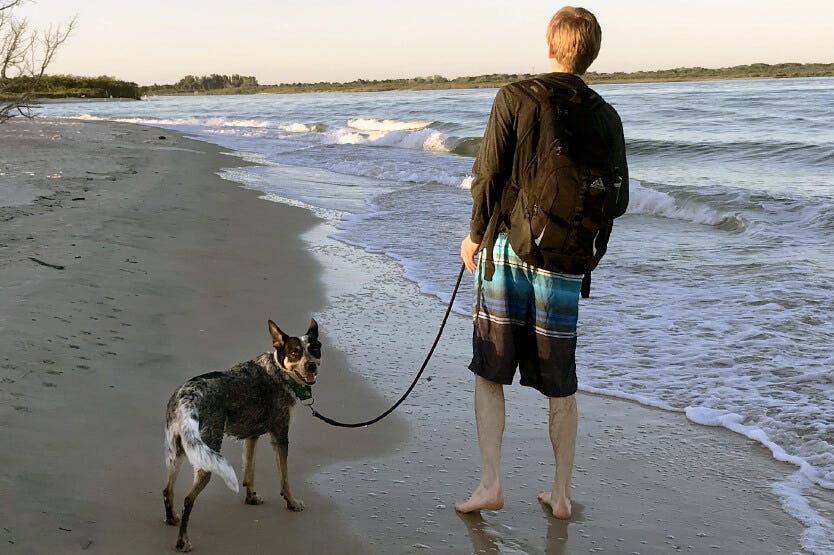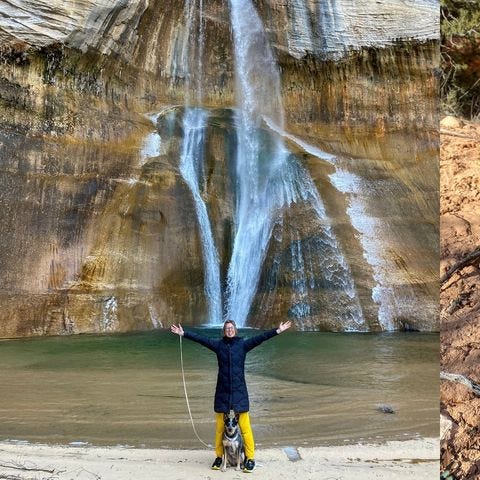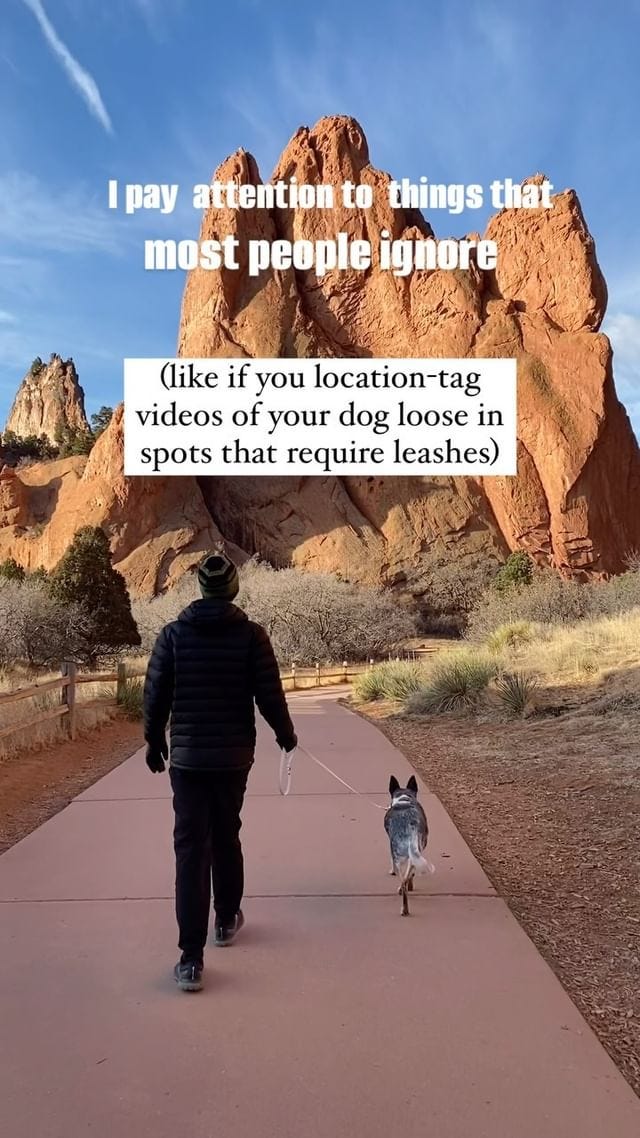Why do dog leash laws matter? (And alternatives to breaking them)
I know it’s tempting to take a look around, see that it’s not too crowded, and unclip your dog anyway.
I first wrote this post in August 2021 and last updated it in July 2024.
Watching your dog run free and just “be a dog” is one of the best sights in the whole world. Sometimes it feels like leash laws just plain suck. I get it!
It’s tempting to take a look around, see that it’s not too crowded, and unclip your dog anyway. I mean, what’s the worst that can happen?
Well, unfortunately… a lot.
From one dog lover to another, I believe the legislative intent of leash laws really does matter. Here are some reasons why—and a few alternatives to completely violating the rules in shared public spaces.
In summary:
Leash laws protect sensitive wildlife and ecosystems
Leashing your dog is kind to those who might be afraid
Leash laws can protect fellow pets
Leashing up can keep your own dog safe
Following the rules can help public spaces stay dog friendly
Alternatives include long lines, retractable leads, renting private yards, and seeking out designated off-leash legal areas
Leash laws protect wildlife
One of the most common reasons hiking trails, beaches, or other natural areas require leashes is to protect wildlife and fragile terrain.
Even a well-behaved dog within visual range of their owner can disrupt sensitive animals or endangered plant species as they venture off of the beaten path!
Our personal beach-lover experiences
We found dogs’ impact on wildlife particularly relevant when we moved to Florida. On the Space Coast’s beaches, sea turtles rely on humans being responsible stewards of the land simply so they have a chance at survival. Even if your dog has perfect recall (something that really doesn’t exist, anyway—no creature is 100 percent reliable, 100 percent of the time) they can still cause a disturbance before you’re able to realize and step in.
The following Instagram post shows some powerful data about how dogs can impact wildlife. (The account itself, @publiclandshateyou, can be a bit brash for my own tastes. But I think we can all get behind the message of protecting our nation’s natural wonders.)
And this next post shows a specific wildlife encounter we had on Cocoa Beach. We saw baby sea turtles! Not only are the videos incredibly adorable (please watch, you’re welcome for the wiggles) but I also share some thoughts on why I was particularly thankful we didn’t violate leash laws this morning.
I appreciate the environment more than ever now that we live on the road
When we moved into our van full time at the start of 2023, my love for the natural world multiplied. I feel incredibly privileged that we get to explore so many beautiful ecosystems with Scout. But they won’t stay beautiful—and we won’t be able to keep experiencing them—if we allow our pets to wreak havoc.
Leash laws help those who are afraid of dogs
Another reason leashes are often required in public places is to ensure everyone can enjoy a comfortable experience.
As hard as it is for a dog-obsessed person like me to swallow, the truth is not everybody likes dogs. And that’s okay. Negative past experiences can give canines a bad reputation for extremely valid reason. Some people have been bitten or watched their loved ones get bitten. Many have sadly never experienced a truly respectful, well-behaved dog to round out their opinion.
As much as I believe in facing and conquering our fears, I would never force someone to deal with my dog without their consent. Scout and I have no more right to use shared public spaces than our neighbors do. We can all work together to balance personal enjoyment with outward respect.
“But my dog is well behaved and stays by my side!”
I hear this a lot. And I get it!
The argument that it’s okay if your dog is off leash in a leashed area because his recall is flawless—and you never let him approach strangers—makes sense on the surface. But it doesn’t always work in practice.
I know people so afraid of canines that if they see a dog off leash in the distance, they simply turn and leave whatever park or trail they’re visiting. The saddest thing is that they specifically go out of their way to select leashed recreational areas just to avoid this very possibility. (We’ve done this exact thing with Scout before. In the earlier days of her reactivity training, it wasn’t worth even a moderate risk we’d be approached without permission.)
From far away, it’s impossible for other trail users to tell if your dog is under control. Will Fido bolt and charge when they get closer? How can they be expected to know about the hours of training you’ve put in when they’ve never met you before?
Many people (myself included) aren’t willing to take that risk in the first place. Highly trained dogs can still ruin someone else’s recreational experience when they’re off leash where they shouldn’t be.
Leash laws protect other dogs
Another sometimes-tough reality: Just because your dog loves saying hi to every person and animal under the sun doesn’t mean everyone else’s pets feel the same way—or that they should!
Reactive, fearful, sensitive, and otherwise in-training dogs deserve to see the world too
Even the friendliest dog in the world can start a dog fight or set another owner months back in their training by approaching uninvited. For dogs who are afraid of other dogs (perhaps after being undersocialized or suffering a previous attack) an unwelcome interaction can have drastic consequences.
Whenever I take Scout somewhere new, I diligently check the leash laws before we go. I call ahead to businesses and confirm that they enforce their policies. I read reviews from other owners to gauge whether or not folks regularly follow the rules.
We do everything in our power to have a successful outing. But not all variables are in our control.
When we are rushed by off-leash dogs, I’m put in an awful position of needing to defend Scout and protect her faith in me while also navigating the extremely awkward human-to-human interaction that’s sure to follow. I’ve been forced to kick out at dogs before. It never feels good. What dog lover wants to have to physically force away a member of their favorite species?!
Scout and I primarily go to areas with leash laws precisely because we don’t want to be greeted by strange dogs. She is always under control in public. We train daily to be respectful members of society. We deserve to enjoy our parks, trails, and beaches just as much as everyone with an over-the-top social dog does!
Uncontrolled pets can disrupt service dogs
Yes: Service dogs are highly trained animals who can deal with a wide range of distractions. No: Service dogs are not robots who are completely unaffected by the environments around them. And out-of-control pets can prevent them from doing their jobs!
For more on what makes a service animal (and why ESAs and therapy dogs do not have public access rights) I recommend going straight to the source: The Americans with Disabilities Act.
Leash laws keep your dog safe
Beyond protecting other dogs and owners (especially those in training), leashes can also keep your dog safe.
Flukes happen. Even the most reliable dog can blow off their recall or bolt into the surrounding wilderness when things hit the fan. Often, leash laws are in place because natural dangers (like rip currents, unseen cliffs, poisonous plants, and more) exist in the nearby area.
What’s more? In areas with leash laws, it’s often legal for other land users to defend themselves from off-leash dogs in some seemingly drastic ways. This depends greatly on the specific community you’re in. But in different places we’ve traveled, reasonable self-defense has ranged from kicking to using pet corrector to spraying pepper gel (or mace) and more.
When these things happen, the owners of off-leash dogs (very understandably!) want to be angry that their four-legged companion has been hurt. But the sad truth is that they only have themselves to blame if they’re the ones breaking the rules and other visitors are acting in good faith.
We can completely avoid this possibility by keeping our dogs leashed and under control when it’s required.
Leash laws enable public areas to stay dog friendly
All of this adds up to one of my most passionate conclusions. If we want our favorite dog-friendly locations to stay dog friendly? The best thing we can do is follow the rules!
I know it’s tedious sometimes. But dog owners who blatantly violate leash laws or other posted notices—especially when they flaunt it on social media with location tags—can quickly ruin it for the rest of us.
Entire beaches have gone from allowing leashed dogs to banning all canines entirely because folks couldn’t follow the rules. Hiking trails have set up cameras to count the number of off-leash offenders, and they’ve shut down when the violations become too many.
Every day, community members in towns across the country petition to close off their public areas from dogs. When we go out there and don’t follow the guidelines, we only add fuel to their flame.
I certainly don’t want to be one of the folks responsible for taking away the amazing privilege of sharing natural wonders with our pets. Instead, we have the power to be good ambassadors.
Some alternatives to fully violating leash laws
Thankfully, there are several alternatives to completely violating leash laws. It might feel a bit more complicated at times, but I firmly believe the respect we show to the public—especially to other dog owners who love their pets just as much as we do!—is well worth it.
Instead of letting our dog off leash in on-leash areas, we:
Use a long line
Some areas have leash length requirements in their rules. Others don’t. In any case, some sort of tether is better than nothing. (I’m a proponent of honoring the legislative intent of leash laws rather than fixating on exact verbiage.)
You can get lightweight long lines that are as long as 50 or 100 feet pretty cheaply off of Amazon, from your favorite pet store, or a range of cute custom collar shops. With a bit of practice learning how to handle the length, you and your dog can enjoy open spaces legally and safely.
Use a retractable leash or flexi lead
Retractable leads get a bad rap in the dog world because owners often misuse them. (Have you ever been charged by a little dog running what seems like miles ahead of their owner? Yeah, us too.)
But in the right hands, flexi leashes can be amazing tools. Professional dog trainer Jay Jack has some great information on how you can actually teach loose-leash walking manners—and boost your dog’s engagement around distractions—with a flexi!
This is one of my go-tos if I want to give Scout more freedom but also make it clear to everyone around us that we’re in control and respecting the intent of the rules. You can read more about how we use our retractable lead here.
Have our dog drag a visible leash
And pick it up (or step on the end) as soon as we see another dog or person in view.
What makes dragging a leash different than letting Scout all the way off and then recalling her to clip back up? Well, we all have slightly different opinions here—but to me, it’s 1) much faster and 2) shows people from farther away that we’re able to have physical control of her.
Anecdotally, in situations where we’ve been charged by unfamiliar dogs, it’s always easy for me to handle if they’re wearing a leash. Then I have 6-8 extra feet with which to grab them and keep them under control until their handler is able to get over to us.
Rent a private dog park or field
As more and more conscientious dog owners realize the dangers of the traditional dog park, private off-leash options rise in popularity. You can look for a space to rent on sites like Sniffspot or even reach out to local community members to see if private landowners might let you use some of their property at designated times!
Head to a designated off-leash area
Off-leash areas exist precisely so that dogs can have a space to run freely without disrupting the general public.
Some of these spots are classic fenced-in dog parks, which we personally avoid. (More on my dog park takes here.) But others are hiking trails, massive fields, or even entire park systems. Check rules online and read reviews from past owners to get a sense of what you’re getting into. Then have some fun together!
Reach out to local parks departments
When we lived in Florida, we were able to get permission from the county to use fenced-in baseball diamonds at off times. Scout could romp around untethered! I can make no promises about how each individual community’s government might respond—but we don’t have anything to lose by asking.
Together, we can keep dog-friendly areas open
As tempting as it is to let your dog gallop across the public beach or around your local park, I can say firsthand how much other users of those public spaces appreciate you being a responsible handler.
Happy caretaking, happy playing, happy leashing!
Further reading
Responsible dog handling—particularly when it comes to respecting those around us—is something I talk about a lot. Here are a few related posts for more context!
How I handle my own emotions when encountering off-leash dogs. I once got into a yelling match with a drunk college guy after his dog charged us. Let me tell you: Whether or not I was “in the right” in the situation, I still felt like utter crap afterward. I like to think I’ve come a long way.
How I decide whether to let Scout off leash. While I love watching my dog run freely, there’s a time, place, and risk assessment to approach it safely. Here’s how I decide whether or not to let her off leash in a given situation.
“On-leash adventure dog” thoughts: “Normalizing adventure dogs on leashes” does not mean “never fulfilling our dogs”. Vice versa: “Prioritizing fulfillment and off-leash time” does not have to equate to “being disrespectful in shared environments”.
An open letter to businesses with roaming shop dogs. I wish it was the norm to let visitors know ahead of time there might be a loose dog present.
A (perhaps too nice in an attempt to not incite defensiveness) open letter to off-leash dog owners. It would mean so much to us if you’d use some sort of leash in environments that call for it.
Questions I’ve been asked by off-leash dog owners. It can be difficult to say the “right” thing when I’m focused on getting out of the situation. Crafting these responses after the fact has been incredibly cathartic.













Dogs should be no where near where kids play baseball or soccer (any sport in grass), even if games aren't being played at the time. Irresponsible dog owners don't pick up their poop. I can't tell you how many times while coaching baseball or soccer a kid comes and tells me they've stepped in dog crap. It's disgusting, smelly, disruptive of the practice/game, AND dangerous. What if a kid falls on it and has an open cut? Please don't allow your dogs on athletic fields, even at off times.
Hey Haley. I just want you to know that I really enjoyed this article. It's insightful and easy to follow. I used this as a source for a paper in my college english class and my professor liked it too. Thank you!